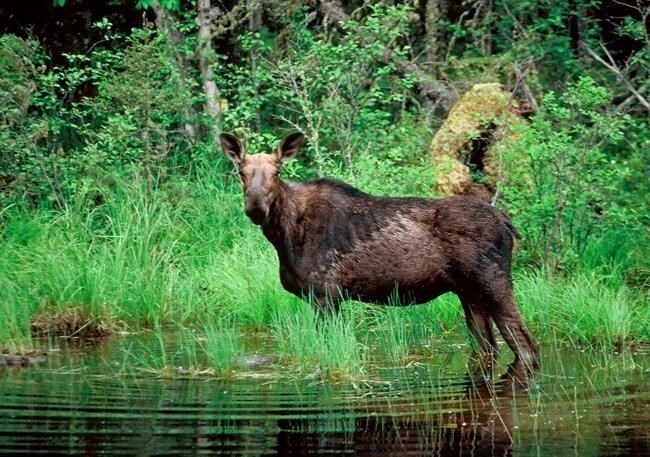
FILE - This undated file photo shows a moose wading in a small pond in the Superior National Forest in Minnesota. The U.S. Fish and Wildlife Service said Thursday, June 2, 2016, they'll investigate whether moose in four Midwestern states should be protected under the Endangered Species Act. The review pertains only to moose in Michigan, Minnesota, Wisconsin and North Dakota. (AP Photo/Jim Mone, File)
June 02, 2016 - 3:26 PM
TRAVERSE CITY, Mich. - Federal officials said Thursday they will consider extending protections under the Endangered Species Act to moose in four upper Midwestern states, including Minnesota, where the hulking symbol of its northern woodlands has suffered a steep population decline in the past decade.
The U.S. Fish and Wildlife Service said a petition submitted last year by two environmental groups had provided "substantial scientific or commercial information" that might justify designating the region's moose as endangered or threatened. The finding triggers a more detailed study, beginning with a 60-day period in which the public can submit information and comments.
The investigation deals only with moose that roam the forests and prairies of Minnesota, Michigan's Upper Peninsula, North Dakota and Wisconsin.
"The Endangered Species Act is the best tool we have to prevent extinction of our moose," said Collette Adkins, a biologist and attorney with the Center for Biological Diversity, which filed the petition with another group, Honor the Earth. "I'm saddened that moose are in such big trouble that they need the act's protection but relieved that help is likely on the way."
Listing the moose under the act would make it illegal to hunt them and could produce habitat protections and federally funded research on their plight.
The situation is especially grim in Minnesota, which has the region's largest moose population. The total in the thickly wooded northeast, their historical stronghold, is estimated at roughly 4,000 — down more than 50 per cent since 2006. Glenn DelGiudice, moose project leader with the state's Department of Natural Resources, said further declines are expected.
Scientists said the drop-off has a number of likely causes, including parasites, disease and wolf predation. The environmental groups also blame a warming climate. Moose are cold-weather creatures, with thick fur that helps them survive low temperatures and long legs ideal for moving through deep snow.
"Rising temperatures and decreasing snowfall put moose at increased risk of overheating, which leads to malnutrition and lowers their immune systems, while ticks and other pathogens thrive in a warming climate," Adkins said.
Things aren't uniformly bad across the region. North Dakota has boosted the number of licenses for its annual moose hunt from 130 in 2015 to 200 this year. Although moose are struggling in the state's eastern forests and swamps, they're thriving in western prairielands along the Missouri River, state wildlife chief Jeb Williams said.
Moose hunting is not allowed in the other three states; Minnesota discontinued it in 2012.
Moose are also surging at Michigan's Isle Royale National Park in Lake Superior, where wolves that have kept the moose in check are on the verge of dying out. On the Upper Peninsula mainland, where officials brought in moose from Canada in the 1980s, the population is estimated at 500 but has stagnated without becoming robust enough to allow hunting.
Moose are listed as "species of special concern" in Michigan and Minnesota but the status provides no legal protections.
Michigan will co-operate with the Fish and Wildlife Service investigation, said Russ Mason, chief of the Wildlife Division.
"Moose are one of Michigan's iconic wildlife species," Mason said.
News from © The Associated Press, 2016